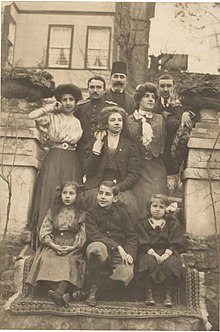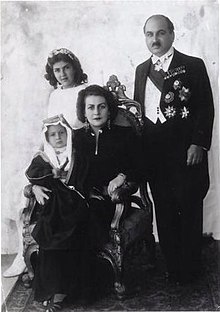Fahrelnissa Zeid
Princess Fahrelnissa Zeid , actually Fahrünnisa Zeyd , ( Arabic الأميرة فخر النساء زيد al-amīra Fachr an-Nisāʾ Zaid ), also Fakhr un-nisa or Fahr-El-Nisa (born January 7, 1901 in Istanbul as Fahrünnisa Şakir ; † September 5, 1991 in Amman ) was a Turkish painter. She was best known for her large-format abstractions, which combined elements of Islamic , Oriental and Byzantine art with influences from Western art.
Life
Childhood and youth

Fahrelnissa Zeid was born in 1901 as Fahrünissa Şakir as the daughter of a wealthy Ottoman family on the island of Büyükada , part of Istanbul . Her uncle Cevat Çobanlı was Grand Vizier of the Ottoman Sultan from 1891 to 1895. Zeid's father Şakir Pascha met his wife Sara İsmet Hanım as an ambassador to Greece.
Zeid's brother Cevat Şakir Kabaağaçlı was a writer and his sister Aliye Berger was also a painter.
Zeid began painting and drawing at an early age. The oldest surviving work is a portrait of her grandmother, which she painted at the age of 14. In 1919 she enrolled at the Art Academy for Women in Istanbul.
At the age of 19, Zeid married the novelist İzzet Melih Devrim in 1920 . The couple's honeymoon took them to Venice, where Zeid first came into contact with European art. The couple had three children: their eldest son Faruk (* 1921) died of scarlet fever in 1924 . The son Nejad (* 1923) became a painter, the daughter Şirin Devrim (* 1926) an actress.
Zeid traveled to Paris in 1928 and enrolled at the Académie Ranson , where she studied with the painter Roger Bissière . After her return to Istanbul in 1929, she enrolled at the Academy of Fine Arts in Istanbul, later Mimar Sinan Üniversitesi .
1930-1944
Zeid divorced Devrim in 1934 and shortly thereafter married the Iraqi Prince Zeid bin Hussein , who had been Iraqi envoy to Turkey since 1932. In 1935 Zeid became the ambassador of the Kingdom of Iraq in the German Empire. The couple moved to Berlin and Zeid held many receptions as the ambassador's wife. Their son Ra'ad was born here in 1936. After the outbreak of World War II in September 1939, Prince Zeid and his family were ordered back to Iraq in September. The Zeids settled in Baghdad .
Fahrelnissa Zeid soon suffered from depression and went to Paris on the advice of a Viennese doctor. She spent the next few years alternately in Paris, Budapest and Istanbul and painted a lot. In 1941 she went back entirely to Istanbul and then concentrated entirely on painting.
Zeid got to know “Gruppe d” there, a group of independent avant-garde painters from the new Turkish republic under Mustafa Kemal Ataturk . Even if she was only a brief member of the artist group, she exhibited with “Gruppe d” in 1944. This encourages them to have their own exhibitions. In 1944 she opened her first exhibition in her house in Istanbul's Maçka district, where she also showed her own work.
1945–1957
In 1945 Zeid cleared the salon of her apartment in Istanbul and held her first solo exhibition there. In the same year she had another solo exhibition in Izmir and in Istanbul the following year. When Zeid's husband was appointed Ambassador to the Court of St James’s in London in 1946 , the family moved to the British capital. Zeid continued to paint and set up a room in the embassy as a studio.
In 1947, Zeid's style changed fundamentally: She no longer painted figuratively and turned to abstraction. She was influenced by the abstract art movements in Paris in the post-war period. She mixed Persian, Byzantine, Cretan and Oriental influences with the concepts, styles and techniques of Western European modernism.
In 1948 she exhibited at Saint George's Gallery in London. Because of their position as members of the royal family of Iraq, many members of British high society and the British royal family attended their vernissages and exhibitions. Art critic Maurice Collis reviewed their exhibition and the two became friends. The prominent French art critic and curator Charles Estienne became one of the main advocates of Zeid's work.
In the following years Zeid lived mainly in Paris and London and worked a lot with large-format abstract paintings with kaleidoscopic patterns. Zeid exhibited in the Dina Vierny gallery in 1953, where she showed her most abstract works such as The Octopus of Triton and Sargasso Sea . The exhibition was also shown at the Institute of Contemporary Arts in London in 1954 . Zeid was at the height of her career in the mid-1950s. During this time she made friends with many international artists who worked heavily with gestural abstractions, including Jean-Michel Atlan , Jean Dubuffet and Serge Poliakoff .
1958-1991
In 1958 Zeid convinced her husband not to go to Baghdad as regent, as he does every year, to represent his great-nephew King Faisal II during his vacation. Instead, the couple went on vacation to their holiday home on the island of Ischia . On July 14, 1958, there was a military coup in Iraq and the royal family was murdered. Prince Zeid and his family barely escaped death. The ambassador was asked to vacate Iraq's London embassy in 24 hours. The coup stopped Zeid's career as a painter and hostess in London.
Zeid and her family moved into an apartment in London and the artist had to run a household for the first time in her life at the age of 57. This experience led to her starting to paint on chicken bones and later creating sculptures from the bones cast in resin , which she called paleokrystalos . As a painter, she visibly moved away from abstraction and, during this time, mainly painted portraits of her family and people close to her.
After Prince Zeid Al-Hussein's death in Paris in 1970, Fahrelnissa Zeid moved to Amman to live with her youngest son Ra'ad bin Zeid in 1975. She founded the Jordanian Fahrelnissa Zeid National Fine Arts Institute in 1976 and taught young women for the next 15 years.
reception
The Cologne Museum Ludwig dedicated an extensive retrospective to her in 1990 as the first western museum.
In October 2012, several paintings were auctioned at Bonhams for £ 2,021,838. It was a record for the artist's work.
In 2017, Tate Modern in London organized a retrospective on the work of Fahrelnissa Zeid. The central exhibition room was dedicated to the large-format abstract paintings by Zeid from the 1940s and 1950s. The last room was dedicated to the portraits Zeid had made during her final years in Amman and the resin sculptures. All work came from international lenders and the Tate Modern acquired Untitled C . The curators were Kerryn Greenberg and Vassilis Oikonomopoulos. The exhibition was also shown later in the Deutsche Bank KunstHalle and in early 2018 in the Sursock Museum in Beirut.
The biography Fahrelnissa Zeid: Painter of Inner Worlds was also published in 2017 on the occasion of the retrospective. It was written by the former student Zeids Adila Laïdi-Hanieh .
The Istanbul Modern lent eight works from and also organized in the spring of 2017, the exhibition Fahrelnissa Zeid with works from his collection from the 1940s to the 1970s.
literature
- Becker, Wolfgang: Fahr-El-Nissa Zeid: between Orient and Occident, paintings and drawings . Collection Ludwig and Institute du Monde Arabe, Aachen / Paris 1990
- Greenberg, Kerryn: Fahrelnissa Zeid . Tate Publishing, London 2017
- Adila Laïdi-Hanieh: Fahrelnissa Zeid: Painter of Inner Worlds . Art / Books, London 2017
- André Parinaud and Suha Shoman: Fahrelnissa Zeid . Royal National Jordanian Institute Fahrelnissa Zeid of Fine Arts, Amman 1984
- Fahrelnissa Zeid: Fahrelnissa Zeid: portraits et peintures abstraites . Granoff Gallery, Paris 1972.
Web links
Individual evidence
- ↑ a b c d e f Şirin Devrim: A Turkish Tapestry: The Shakirs of Istanbul . Quartet, London 1996
- ↑ a b Istanbul Modern displays vivid, colorful art by Fahrelnissa Zeid , Daily Sabah, June 3, 2017
- ↑ a b c d e f g h i j Kerryn Greenberg: Fahrelnissa Zeid . Exhibition catalog, Tate Publishing, London 2017
- ↑ Untitled, Fahrelnissa Zeid, c.1950s , Tate Modern
- ↑ Fahrelnissa Zeid: Deutsche Bank Kunsthalle, Berlin , kulturnews.de, October 25, 2017
- ↑ Bonhams sets new world record for Turkish Artist Fahrelnissa Zeid , Bonhams, October 2, 2012
- ↑ Fahrelnissa Zeid - Exhibition at Tate Modern , Tate Modern
- ^ A b Hannah Ellis-Petersen: Fahrelnissa Zeid: Tate Modern resurrects artist forgotten by history . In: The Guardian , June 12, 2017
- ↑ Fahrelnissa Zeid ( page no longer available , search in web archives ) Info: The link was automatically marked as defective. Please check the link according to the instructions and then remove this notice. , Museum Portal Berlin
- ↑ Fahrelnissa Zeid - İstanbul Modern , Istanbul Modern
| personal data | |
|---|---|
| SURNAME | Zeid, Fahrelnissa |
| ALTERNATIVE NAMES | Şaki, Fahrünisa (maiden name); Fahrünnisa Zeyd; Zeid, Fakhr un-nisa; Zeid, Fahr-El-Nissa; Zayd, Fahrelnissa |
| BRIEF DESCRIPTION | Turkish artist |
| DATE OF BIRTH | January 7, 1901 |
| PLACE OF BIRTH | Istanbul |
| DATE OF DEATH | 5th September 1991 |
| Place of death | Amman |

